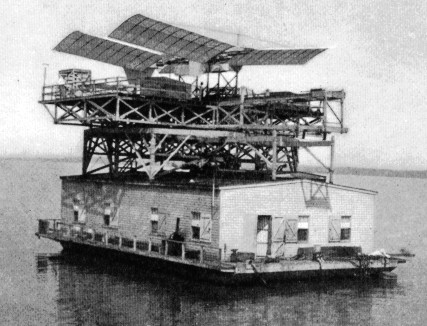Wright and Langley
Today, we look at an attempt to rewrite history. The University of Houston's College of Engineering presents this series about the machines that make our civilization run, and the people whose ingenuity created them.
The close of the 19th century saw Samuel Pierpoint Langley and Orville and Wilbur Wright laboring to create powered controlable flight. Langley worked with government support and enormous public exposure, while the Wright brothers worked quietly using their own resources.
Langley attempted flight on October 7th, 1903. His huge 54-foot-long flying machine had two 48-foot wings -- one in front and one in back. It was launched from a catapult on the Potomac River, and it fell like a sack of cement into the water. On December 8th he tried again. This time the rear wing caved in before it got off its catapult.
Just nine days later, the Wright brothers flew a trim little biplane, with almost no fanfare, at Kitty Hawk, North Carolina. Their advantage was that they'd mastered the problem of controlling the movement of their plane, and they'd preceded their work with four years of careful experimentation with kites and gliders.
But the government makes an interesting bedfellow. Charles Walcott, a long-time friend of Langley's who'd been influential in funding his work, was made director of the Smithsonian Institution in 1906 -- the same year Langley died. He immediately set up a Langley medal, a Langley Aero Lab, a Langley memorial. And then, in 1914, he funded Glenn Curtiss, who'd been involved in a bitter patent dispute with the Wrights, to reconstruct the Langley machine and show that it really could fly.
Curtiss went to work, strengthening the structure, adding controls, reshaping it aerodynamically, relocating the center of gravity -- in short, making it airworthy. In 1914 he flew it for 150 feet, and then he went back and replaced the old motor as well. On the basis of Curtiss's reconstruction, the Smithsonian honored Langley for having built the first successful flying machine.
In 1925 Orville Wright at last roused American opinion to his cause by placing the original airplane -- this American treasure -- in the Science Museum of London. In 1942 the Secretary of the Smithsonian, Charles Abbot, finally authorized publication of an article that clearly showed the Langley reconstruction was rigged. Orville responded by telling the British that his airplane should be returned to the Smithsonian Institution after the war. He died in January, 1948, and 11 months later the first airplane returned to America -- to the Smithsonian -- where it now hangs over a label giving the Wright brothers their due.
Today, of course, Langley's name graces a major NASA center, an Army airbase, and the CIA headquarters. But justice nevertheless seems to have prevailed for the Wright brothers.
I'm John Lienhard, at the University of Houston, where we're interested in the way inventive minds work.
(Theme music)
Crouch, T. D., The Feud Between the Wright Brothers and the Smithsonian. American Heritage of Invention & Technology, Spring 1987, pp. 34-46.
This episode has been reworked as Episode 1342.

(From The Art of Flying, 1911)
The launching platform for the Langley Aerodrome was a houseboat